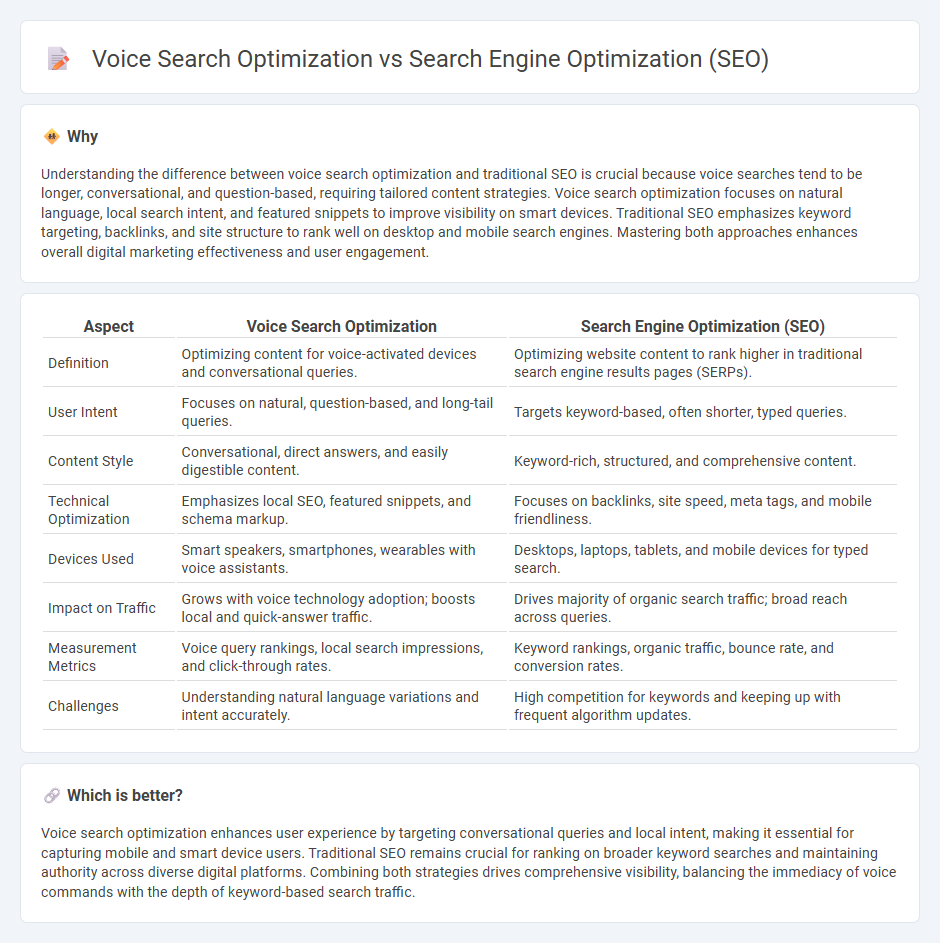
Voice search optimization focuses on tailoring content for conversational queries and natural language patterns, enhancing visibility on voice-activated devices like smartphones and smart speakers. Search engine optimization (SEO) primarily targets keyword relevance, backlinks, and site structure to improve rankings on traditional search engines like Google. Explore the key differences and strategies to boost your marketing effectiveness by learning more about both approaches.
Why it is important
Understanding the difference between voice search optimization and traditional SEO is crucial because voice searches tend to be longer, conversational, and question-based, requiring tailored content strategies. Voice search optimization focuses on natural language, local search intent, and featured snippets to improve visibility on smart devices. Traditional SEO emphasizes keyword targeting, backlinks, and site structure to rank well on desktop and mobile search engines. Mastering both approaches enhances overall digital marketing effectiveness and user engagement.
Comparison Table
| Aspect | Voice Search Optimization | Search Engine Optimization (SEO) |
|---|---|---|
| Definition | Optimizing content for voice-activated devices and conversational queries. | Optimizing website content to rank higher in traditional search engine results pages (SERPs). |
| User Intent | Focuses on natural, question-based, and long-tail queries. | Targets keyword-based, often shorter, typed queries. |
| Content Style | Conversational, direct answers, and easily digestible content. | Keyword-rich, structured, and comprehensive content. |
| Technical Optimization | Emphasizes local SEO, featured snippets, and schema markup. | Focuses on backlinks, site speed, meta tags, and mobile friendliness. |
| Devices Used | Smart speakers, smartphones, wearables with voice assistants. | Desktops, laptops, tablets, and mobile devices for typed search. |
| Impact on Traffic | Grows with voice technology adoption; boosts local and quick-answer traffic. | Drives majority of organic search traffic; broad reach across queries. |
| Measurement Metrics | Voice query rankings, local search impressions, and click-through rates. | Keyword rankings, organic traffic, bounce rate, and conversion rates. |
| Challenges | Understanding natural language variations and intent accurately. | High competition for keywords and keeping up with frequent algorithm updates. |
Which is better?
Voice search optimization enhances user experience by targeting conversational queries and local intent, making it essential for capturing mobile and smart device users. Traditional SEO remains crucial for ranking on broader keyword searches and maintaining authority across diverse digital platforms. Combining both strategies drives comprehensive visibility, balancing the immediacy of voice commands with the depth of keyword-based search traffic.
Connection
Voice search optimization enhances Search Engine Optimization (SEO) by targeting natural language queries and long-tail keywords commonly spoken in voice commands. Integrating voice search strategies improves website ranking on search engines like Google by matching user intent more accurately. Leveraging structured data and local SEO further boosts visibility through voice-activated devices and digital assistants.
Key Terms
Keywords
Optimizing for voice search requires targeting natural, conversational keywords that reflect how users speak, contrasting with traditional SEO's emphasis on concise, typed queries. Long-tail keywords and question phrases dominate voice search, enhancing relevance for virtual assistants like Alexa and Google Assistant. Explore comprehensive strategies to effectively balance keyword use for both SEO and voice search optimization.
User Intent
Search engine optimization (SEO) traditionally targets keywords typed into search engines, while voice search optimization emphasizes natural language and conversational queries that reflect real user intent. Voice search prioritizes context, local results, and question-based phrases, requiring content tailored to how users speak rather than type. Explore more strategies to align your content with evolving user intent in voice and text search environments.
Structured Data
Structured Data enhances search engine optimization (SEO) by providing clear context to search engines, improving webpage indexing and rich snippet generation. For voice search optimization, Structured Data enables voice assistants to accurately interpret and deliver precise answers from your content. Explore how leveraging Structured Data can boost both traditional SEO and voice search performance.
Source and External Links
What is SEO? The Complete Search Engine Optimization - SEO is the practice of getting targeted, organic traffic to a website by optimizing for search engines to rank higher on relevant keyword queries and improve user experience.
What is SEO? (Search Engine Optimization) - SEO involves creating and optimizing relevant, authoritative content so that search engines can better understand and rank the content, increasing the quantity and quality of organic traffic to your site.
What Is SEO - Search Engine Optimization? - SEO helps search engines deliver relevant, valuable results by improving site visibility on search engines through optimizing for the keywords that matter most to your target audience.
 dowidth.com
dowidth.com